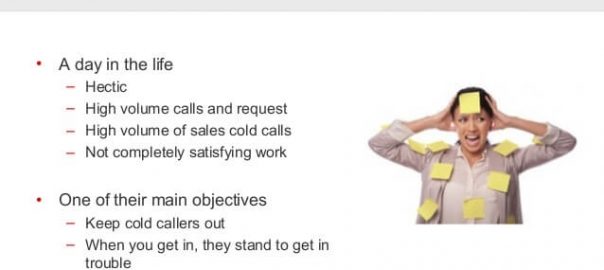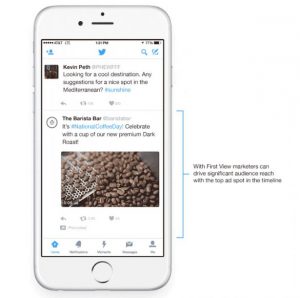Reaching an important decision maker directly is always a challenge. They usually have people employed to take their calls to filter out sales reps and anyone else not deemed to be directly important. These are the Gatekeepers. Your sales success depends on knowing how to get past the gatekeeper.
You should never flog a dead horse, as the saying goes.
If you have approach the decision maker directly, and you’ve been sidelined by the gatekeeper — that avenue of contact won’t work. You will need to find a way past the gatekeeper. One that works.
The irritating part of all this is that the gatekeeper possibly doesn’t understand too much about the business that the decision maker is involved in. This can be especially annoying when you ‘know’ that the decision maker would definitely benefit from what you have to offer.
All the gatekeeper knows is that you are selling something, and they have been told to filter out all sales reps. That means you are not going to get anywhere near the inner sanctum, if the gatekeeper has anything to do with it.
The gatekeeper’s job isn’t to stop everyone getting to the decision maker. Part of their job is to ensure that the right people get seamlessly easy access. If you are not one of the ‘right people,’ then the second part of the gatekeeper’s job kicks in – making sure the wrong people are kept out.
Can I learn how to get past the gatekeeper?
There are a number of ways that might get you past the gatekeeper. You may need to be a little bit devious and think outside the box, though. Let’s examine seven ways that have the potential to get you past the gatekeeper to access with the decision maker.
1. The gatekeeper is just a person, after all.
They will respond to the same kinds of things that most people do. Befriend the gatekeeper. They will respond to a friendly approach much better than a demanding one.
Here’s a great resource to help you get into the mind of many gatekeepers:
![How to Get Past the Gatekeeper [A Guide to Getting Contact with Decision Makers] How to Get Past the Gatekeeper [A Guide to Getting Contact with Decision Makers]](https://www.onlinesalesguidetip.com/wp-content/uploads/2020/01/How-to-Get-Past-the-Gatekeeper-A-Guide-to-Getting-Contact-with-Decision-Makers.jpg)
(Source)
Try to establish a rapport with the gatekeeper. Start by using the gatekeeper’s name. Make it personal. Be polite, respectful and honest, as well as friendly, and you will greatly increase your chances of getting access.
Never forget that the gatekeeper does not have the final say. Their authority does not allow them to absolutely exclude you for getting access to the decision maker. Polite persistence could pay off. Even after rejection, try sending them an email setting up a time to call back.
2. You can try going above the gatekeeper, or going below them.
There will be someone superior to the gatekeeper, other than the person you are trying to reach. If you can get through to the person above the gatekeeper, you have a very good chance of getting through to the decision maker.
The same goes for the person below the gatekeeper. Remember, both of these people do not have it in their job remit to block the ‘wrong people’ from gaining access to the decision maker. If you can persuade either of them that you really should gain access, there’s a very good chance you will.
3. The one thing that many sales reps don’t usually consider is the possibility that the gatekeeper might go home at the end of the working day before the boss does.
Try calling at a time after the gatekeeper has left. You just might find the decision maker answering the phone.
Another good reason for doing this is that most people will have likely stopped working at this time. The boss might be impressed that you are obviously still working, just as he/she is. Your dedication to hard work, or the decision maker’s perception of it at least, might pay off.
A poll of decision makers has revealed that some 78% of them will sometimes respond favorably to a call they receive, but only if the gatekeeper has already gone home, or isn’t around for whatever reason.
If you know the decision maker is in his/her office, then very early in the morning, or late in the evening is by far the best time to call.
4. Try to contact the decision maker directly through social media.
It is not commonly the gatekeeper’s job to manage the boss’s social media profiles. Try LinkedIn first. Their In-mail feature could get you direct access. You could also try Twitter or Facebook.
LinkedIn is usually the best social media platform to make contact with. It is generally considered to be the most serious, and important decision makers usually have a LinkedIn profile.
According to the research of Brandon Gaille, at least 48% of all LinkedIn members are in a decision-making role. There are now over 500 million LinkedIn members, which means an awful lot of decision makers are active on the platform.
5. One very effective, if slightly devious, way of knowing how to get past the gatekeeper is to let them think you actually know the decision maker, and that you are on first name terms with them.
How can you do this?
Simply say something like. “Hi, it’s Joe Bloggs here. Is Bob in?” This is much better than asking if ‘Mr. Smith is in.’ The gatekeeper may well think that you know ‘Bob’ personally, and catching him/her off-guard like this might well be all it takes to give you the access you need. Be confident, or at least, sound confident!
6. Ask the gatekeeper to help you.
Honesty is often the best approach. When all else fails, try asking if they know of any way they can help you – anything at all. Laying yourself bare like that might just touch a nerve with the gatekeeper, and you might get what you want.
7. When you find yourself speaking to a gatekeeper, don’t waste time.
According to Wyzowl, you only have 30 seconds at best to make an impression with the gatekeeper. Your first 10 seconds should be snappy and straight to the point. Then you can expand a bit, but still keep it tight and focused.
Business & Finance Articles on Business 2 Community
(89)
Report Post




